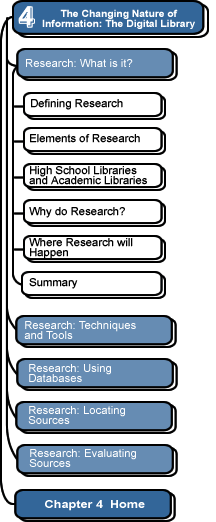

What does the product of an expert researcher look like? To provide a concrete example of the research process, we will dissect a biology article in the field of genetic engineering and examine the research effort that went into it. This article is a significant piece of scholarship, something an expert researcher would write. While you would not have the subject expertise or time to complete such a project during your time in college, it provides an opportunity to learn from the experts.
- Title
- Number of References
- Types of References
- Notice the Range of Years
- Scholarly
- Notice That No Article Deals Exactly with the Topic
- Research Hints
- What's Not Noticeable
Title
The title is a gauge of how clearly you understand your topic and the benchmark for determining whether you are staying focused on your topic.
View this ![]() article entitled "Commercialization of transgenic plants" (hereafter
referred to as the Commercialization Example).
article entitled "Commercialization of transgenic plants" (hereafter
referred to as the Commercialization Example).
The authors decided
to focus on the genetic engineering of commercial plants, like corn
or wheat, and not wild plants. Notice the subheading following the colon.
This is an important technique for clearly narrowing a topic. Genetic
engineering of commercial plants is the main topic of the study, but only
the ecological risks will be dealt with fully. This means health
issues and government regulation issues will either not be covered or be covered
tangentially. If the authors had not added the subheading, "potential
ecological risks," the topic would have been far too broad and unmanageable.
On the other hand, if the title had been "Commercialization of transgenetic
plants: Bacillus thuringiensis and herbicide-tolerant legume," the
researchers might not have found enough information to build a paper of reasonable
length. To write a successful research paper, the thesis statement
must be clear and concise and neither too broad nor too narrow.
goto
top
Number
of References
Notice
in the Commercialization ![]() the number of references the authors used: seventy-one. The more sources
you find, the easier it will be to write a high-quality research paper.
As a general rule, collect twice as many sources as your professor requires.
You can then evaluate them critically, and you will have the luxury of
eliminating those that are inferior or miss the focus of your thesis statement.
The authors of this article probably had hundreds of sources to choose
from but felt that these were the most relevant.
the number of references the authors used: seventy-one. The more sources
you find, the easier it will be to write a high-quality research paper.
As a general rule, collect twice as many sources as your professor requires.
You can then evaluate them critically, and you will have the luxury of
eliminating those that are inferior or miss the focus of your thesis statement.
The authors of this article probably had hundreds of sources to choose
from but felt that these were the most relevant.
goto
top
Types
of References
 Notice
the different types of references in the
Commercialization
Notice
the different types of references in the
Commercialization ![]() .
Most of the references are for journal articles (Adler, Arias, Bartels,
etc.), several are for books (Anderson, Baum, Gatehouse, etc.), two are
for websites (APHIS and NBIAP), two are for papers given at a conference
(Gould 1992 and Krattiger), and one refers to a government document (Snow).
Heavy dependence on journal articles is typical for most disciplines in
the sciences and the social sciences. The humanities, as a rule, rely
equally on books and journals. However, each discipline has its own unique
sources of knowledge. Become knowledgeable concerning where information
in your discipline is most readily found.
.
Most of the references are for journal articles (Adler, Arias, Bartels,
etc.), several are for books (Anderson, Baum, Gatehouse, etc.), two are
for websites (APHIS and NBIAP), two are for papers given at a conference
(Gould 1992 and Krattiger), and one refers to a government document (Snow).
Heavy dependence on journal articles is typical for most disciplines in
the sciences and the social sciences. The humanities, as a rule, rely
equally on books and journals. However, each discipline has its own unique
sources of knowledge. Become knowledgeable concerning where information
in your discipline is most readily found.
goto
top
Range
of Years
 Notice
the range of years in the Commercialization
Notice
the range of years in the Commercialization
![]() .
There are 31 references (44%) to material published in 1994, 1995, and
1996, the three years previous to the publication year. This is to be
expected in a fast-changing field like genetic engineering. Expectations
vary from discipline to discipline and topic to topic. In some areas,
the definitive works might have been written three decades or three centuries
ago. As a general rule, your professor will expect you to locate current
scholarship on the subject as well as important historical sources. Notice
the authors reference a number of "classics." To better understand how
oats and millet propagate, the authors cited the 1977 books by Baum and
Brunken on the subjects. It's important for the researcher to understand
what has already been written on the subject. Also, there are nearly as
many references to sources published in the 1980s as there are to sources
published in the 1990s. To write intelligently on a topic today,
you must understand what went on before. Successful scholars stand on
the shoulders of those who went before them.
.
There are 31 references (44%) to material published in 1994, 1995, and
1996, the three years previous to the publication year. This is to be
expected in a fast-changing field like genetic engineering. Expectations
vary from discipline to discipline and topic to topic. In some areas,
the definitive works might have been written three decades or three centuries
ago. As a general rule, your professor will expect you to locate current
scholarship on the subject as well as important historical sources. Notice
the authors reference a number of "classics." To better understand how
oats and millet propagate, the authors cited the 1977 books by Baum and
Brunken on the subjects. It's important for the researcher to understand
what has already been written on the subject. Also, there are nearly as
many references to sources published in the 1980s as there are to sources
published in the 1990s. To write intelligently on a topic today,
you must understand what went on before. Successful scholars stand on
the shoulders of those who went before them.
goto
top
Scholarly
Sources
Notice
that all the journal references in the Commercialization ![]() are from scholarly journals
(in a later section we'll discover how to tell a scholarly journal from
a popular magazine.) You'll be able to use a few articles from popular
magazines, such as Time and Newsweek, but most of your sources
will have to be from scholarly journals.
are from scholarly journals
(in a later section we'll discover how to tell a scholarly journal from
a popular magazine.) You'll be able to use a few articles from popular
magazines, such as Time and Newsweek, but most of your sources
will have to be from scholarly journals.
goto
top
Tangential
References
Notice that
no article in the Commercialization ![]() deals exactly with the topic. It's the rare article that covers a research
topic exactly. Chances are you will need to look for articles that address
your topic from a number of different viewpoints. For example, some of
the sources look at only one type of plant, others deal with plant genetics,
while others focus on resistance to viruses. It will be up to you to synthesize
all that material into your paper.
deals exactly with the topic. It's the rare article that covers a research
topic exactly. Chances are you will need to look for articles that address
your topic from a number of different viewpoints. For example, some of
the sources look at only one type of plant, others deal with plant genetics,
while others focus on resistance to viruses. It will be up to you to synthesize
all that material into your paper.
goto
top
Research
Hints
Look
for research hints in the references. Notice in the Commercialization
![]() that Gould, F. is listed five times. This may indicate an authority
on the subject.
that Gould, F. is listed five times. This may indicate an authority
on the subject.  Similarly,
if several authors cite the same author, then it's safe to assume that this
person is an expert on the subject and that other books and articles by this
author should be sought. Or, you may discover a useful phrase that may
lead to other useful articles. For example, Bacillus thuringiensis might
be a bacteria worth examining more carefully. Research requires that
you pay attention to all the clues and hints scattered along the way.
Similarly,
if several authors cite the same author, then it's safe to assume that this
person is an expert on the subject and that other books and articles by this
author should be sought. Or, you may discover a useful phrase that may
lead to other useful articles. For example, Bacillus thuringiensis might
be a bacteria worth examining more carefully. Research requires that
you pay attention to all the clues and hints scattered along the way.
goto
top
What's
Missing?
 There
is no evidence of the blood, sweat, and tears the authors shed! Everything
is nicely polished, and arguments flow smoothly into each other. The
introduction clearly identifies the issues, and the conclusion summarizes
the findings. But if the authors were to stand before you, they would
describe their journey, their long days and nights locating sources, the
frustrating dead ends, and the continual revising and rewriting.
There
is no evidence of the blood, sweat, and tears the authors shed! Everything
is nicely polished, and arguments flow smoothly into each other. The
introduction clearly identifies the issues, and the conclusion summarizes
the findings. But if the authors were to stand before you, they would
describe their journey, their long days and nights locating sources, the
frustrating dead ends, and the continual revising and rewriting.
goto
top
![]()
![]()
These pages were
written by Glenn Remelts.
and edited by Jeffrey L. Nyhoff and Nancy Zylstra
©2005 Calvin University (formerly Calvin College), All Rights Reserved
If you encounter technical errors, contact computing@calvin.edu.